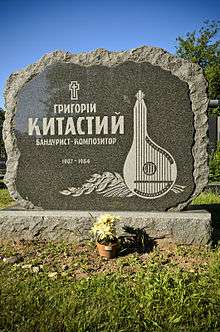Hryhory Kytasty

Hryhoriy Trokhymovych Kytasty (Ukrainian: Григорій Трохимович Китастий) (January 17, 1907 – April 6, 1984) was a Ukrainian émigré composer and conductor. In 2008 he was honored with the Hero of Ukraine state decoration.[1]
Biography
Early years
Hryhory Kytasty was born in the town of Kobeliaky, Poltava oblast.[2] After completing initial music studies at the Poltava Musical College, Kytasty studied under Mykola Hrinchenko, Levko Revutsky and Viktor Kosenko at the Institute of Music and Drama named after Mykola Lysenko from 1930-35 in Kiev.[2] He completed his studies there in choral conducting majoring in Operatic choral conducting. He learned to play the bandura quite late in his life.
The Bandura and the Kiev State Bandurist Capella
After graduating in 1935 he joined the Kiev Bandurist Capella and continued to refine his playing of the bandura. In 1937 he became concertmaster and in 1939 the assistant conductor. During this time Kytasty's first arrangements and compositions began to be played and recorded by the Capella.
With the Nazi invasion of the Soviet Union, the Kiev State Bandurist Capella was disbanded and its members were mobilized to the front. Although recruited, H. Kytasty was able to avoid being sent to the front.
The Shevchenko Bandurist Capella in Europe
The members of the Kiev Bandurist Capella who had survived, during the German occupation re-established a professional ensemble. In 1942, Kytasty became the artistic director of this reconstituted Bandurist Capella which in time became known as the Shevchenko Bandurist Capella. During the course of the war the Capella toured Western Ukraine and Volyn and was later in Germany to perform for the Ost-arbeiters. In Germany, after initially being incarcerated in Hamburg, they were released to perform for the Ostarbeiters housed in special work camps in order help raise the productivity of those who worked in near slave like conditions.
It is in Germany that the Shevchenko Bandurist Capella finds itself at the end of the War. Because of the brutal manner in which Ukrainian artists were treated under the Stalinist regime, and the fact that many bandurists had suffered directly or had witnessed unfounded reprisals under the Soviet regime, the Chorus as a group decided not to return to Soviet Ukraine and in 1949 emigrated as a group to the United States. Another significant reason for emigration was justified fear of persecution for collaborating with the Nazis during the occupation.
The Ukrainian Bandurist Chorus in North America

In 1949 H. Kytasty emigrated to the United States, settling initially with the rest of the Chorus in Detroit. In the United States the Shevchenko Bandurist Capella changed its name in English to the Ukrainian Bandurist Chorus. After numerous attempts were made to set the Ukrainian Bandurist Chorus as a professional ensemble, the members settled down to permanent employment in Detroit mainly associated with jobs in the automobile industry.
In 1958 H. Kytasty toured Europe as a co-director with Volodymir Bozhyk of the Ukrainian Bandurist Chorus. Although the tour was an artistic success, it did not allow the group to a professional status. Upon returning to the USA Kytasty left the Chorus and moved to San Diego. In 1964 he left San Diego and moved initially to Minneapolis and then Chicago, finally settling in Cleveland. In this period he directed various church choirs and bandura groups. In 1967 he returned to the artistic directorship the Ukrainian Bandurist Chorus which he continued to direct until his death in 1984.
H. Kytasty is buried at a large Ukrainian Orthodox cemetery behind St. Andrew's Memorial Church in South Bound Brook, New Jersey. His grave can be found in the front row on the left side of the cemetery (opposite the parking lot).
Works
Compositions and Arrangements
Kytasty is known as a composer who captured the spirit of the Ukrainian emigration who were branded Diplaced Persons from Easteren Europe, reflecting the aspirations of the Western Ukrainin Diaspora. His musical arrangements and compositions can be divided up into three periods: I) Soviet period (from 1934-1942) 2) War and post war period (from 1942-1958) 3) Diaspora period (from 1958-1984)
Initially he composed works which reflected the needs and tastes of the Soviet environment in which he was educated and lived, composing soviet political works such as the Song of the NKVD and the Chekist and folkloric arrangements that reflected the governments approach to Ukrainian culture and song.
In the World War II and immediate post World War II period he composed and arranged songs which reflected the struggle of the Ukrainian people against communist dictatorship and tyranny. His compositions from this period are considered to be very nationalistic.
In his third period, when it became apparent that the Soviet Union would not flounder soon, his compositions became more subtle and lyrical and reflected a longing for his homeland. (Yak davno), (Ne shkoduyu) and lost youth.
His instrumental bandura works demonstrate a knowledge of effective devices on the bandura.
Recordings
Hryhory Kytasty's first recorded arrangement was "Oj nastupyla ta chorna khmara" recorded by the Kiev Bandurist Chorus directed by Danylo Pika in 1939 (record number B8691). The reverse of the record has "Oj za hory zza lymanu" arranged by M. Mykhailov (record number B8692).
Kytasty's arrangement of the Ukrainian folk song "A mij mylyj umer" was recorded by the Kiev State Bandurist Chorus and released in 1937 (#5168).
Before World War II Kytasty recorded as a member of a bandura quintet an instrumental Polka with D. Pika, V. Savchenko, S. Minialo, and O. Kostetsky. This recording was released a number of times in 1937 and 1940 (record # 5169 and 5149).
Sources
Kudrytsky, A. V. - Mystetstvo Ukrainy - Biohrafichnyj dovidnyk, K, 1997
References
- ↑ Ukrgeroes. "Kytasty Gregory T.". Ukrgeroes.narod.ru. Retrieved 23 July 2013.
- 1 2 Kubijovyc, Volodymyr. "Hryhory Trokhymovych Kytasty, CONDUCTOR". Bandura.org. Retrieved 23 July 2013.